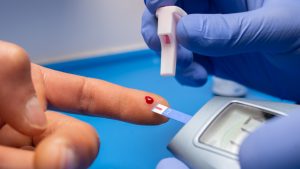Eating a healthy diet is essential for people with diabetes, especially those with type 2 diabetes. Choosing the right foods can help you control your blood sugar levels, prevent complications, and improve your quality of life.

Benefits of a Healthy Diet for Type 2 Diabetes:
- Blood sugar control: Fiber, abundant in this type of diet, helps slow down the absorption of sugar into the bloodstream, contributing to better glycemic control.
- Weight loss: Most of the foods included in this plan are low in calories and nutrient-dense, promoting gradual and sustainable weight loss, a crucial factor in type 2 diabetes management.
- Reduced risk of complications: A healthy diet can lower the risk of developing heart disease, stroke, diabetic nephropathy, and diabetic retinopathy, common complications of type 2 diabetes.
- Improved overall health: This type of diet provides essential vitamins, minerals, and antioxidants that strengthen the immune system, reduce inflammation, and promote overall well-being.
Recommended Foods:
- Vegetables: Broccoli, spinach, cauliflower, tomatoes, peppers, carrots, onions, and garlic.
- Fruits: Apples, oranges, pears, berries, strawberries, and kiwis (in moderation).
- Legumes: Lentils, chickpeas, beans, fava beans, and peas.
- Nuts and seeds: Almonds, walnuts, Brazil nuts, flaxseeds, chia seeds, and pumpkin seeds.
- Whole grains: Oats, quinoa, brown rice, and whole-wheat bread.
Foods to Limit or Avoid:
- Added sugars: Sugary drinks, sweets, processed desserts, and other high-sugar foods.
- Refined flours: White bread, white rice, white pasta, and products made with these flours.
- Saturated and trans fats: Red meat, processed meats, full-fat dairy products, and processed foods.
- Sodium: Table salt, processed foods, and sauces with high sodium content.
Additional Recommendations:
- Meal planning: Planning meals ahead of time helps make healthy choices and control portions.
- Reading nutrition labels: Pay attention to the sugar, saturated fat, sodium, and fiber content of the foods you buy.
- Consuming moderate portions: Avoid overeating and control portion sizes.
- Proper chewing: Chewing food well helps control appetite and digestion.
- Adequate hydration: Drink enough water throughout the day to stay hydrated and regulate blood sugar levels.
- Regular physical activity: Engage in at least 30 minutes of moderate-intensity physical activity most days of the week.
- Consultation with a healthcare professional: A registered dietitian or diabetes educator can create a personalized meal plan and provide additional guidance.
Studies of Interest:
- ACCORD Study: This study demonstrated that a high-fiber, low-saturated-fat diet reduced the risk of cardiovascular complications in people with type 2 diabetes. (https://pubmed.ncbi.nlm.nih.gov/17599422/)
- DPP Study: The DPP Study found that a low-calorie, high-fiber diet, along with lifestyle changes, was as effective as metformin in controlling blood sugar in people with type 2 diabetes. (https://repository.niddk.nih.gov/studies/dpp/)
- Look AHEAD Study: This study showed that a low-calorie, high-fiber diet, combined with physical activity, led to significant weight loss and improved blood sugar control in people with type 2 diabetes. (https://repository.niddk.nih.gov/studies/look-ahead/)
E4 Helps you with your diet:
E4 Diabetes Solutions offers an innovative continuous glucose monitoring system (CGM) and a comprehensive program called E4 Alive, designed to empower people with type 2 diabetes to take control of their health.
E4 Alive provides a combination of tools and personalized support to help you:
- Better understand your glucose levels: The E4 CGM system provides accurate, real-time data about your glucose levels, allowing you to identify patterns and make informed decisions about your diet and lifestyle.
- Manage your diet: E4 Alive offers resources and tools to help you create a healthy eating plan tailored to your individual needs.
- Embrace an active lifestyle: The E4 Alive program motivates and supports you in incorporating regular physical activity into your daily routine.
- Connect with a community: E4 Alive provides access to a community of people with type 2 diabetes who share experiences and offer mutual support.
By joining E4 Alive, individuals with type 2 diabetes can:
- Reduce their blood glucose levels
- Improve their long-term glycemic control
- Lower their risk of diabetes-related complications
- Enhance their overall quality of life
E4 Alive is an opportunity for those with type 2 diabetes to take charge of their health and live a fuller life.
To learn more about E4 Diabetes Solutions and the E4 Alive program, visit THIS PAGE.

Type 2 Diabetes: Is It Really Reversible?
A recent National Geographic article [link] explores how type 2 diabetes could be reversible with the right approaches. This condition, which affects millions of people worldwide, has long been considered a chronic and progressive disease. However, recent research challenges this perception and suggests that with lifestyle changes and the right approach, remission is possible. The

How Do GLP-1 Drugs Compare? A Breakdown of Ozempic, Mounjaro, and Trulicity
GLP-1 receptor agonists have revolutionized diabetes management, with drugs like Ozempic, Mounjaro, and Trulicity leading the market. But how do these medications compare in terms of effectiveness, side effects, and patient outcomes? Let’s explore their differences and what they mean for diabetes patients. Understanding GLP-1 Medications GLP-1 receptor agonists mimic a natural hormone that helps

Why Has Medicare Spending on Diabetes Medications Skyrocketed in 5 Years?
In the past five years, Medicare spending on diabetes medications has increased nearly fivefold, reaching $35.8 billion in 2023. This surge has been primarily driven by the growing use of GLP-1 drugs such as Ozempic, Mounjaro, and Trulicity. But what is behind this cost escalation, and how does it affect patients and the U.S. healthcare

The Gut Microbiota and Blood Sugar Control: A Hidden Connection
The human gut is home to trillions of bacteria that play a crucial role in digestion, immune function, and even metabolism. Recent research has revealed a fascinating link between the gut microbiota and blood sugar regulation, shedding light on how the balance of microbes in our intestines can influence diabetes risk and overall metabolic health.

The Dawn Phenomenon: Why Blood Sugar Rises While You Sleep
For many people with diabetes, waking up with high blood sugar levels can be frustrating—especially if they didn’t eat anything overnight. This early-morning spike in blood glucose is known as the Dawn Phenomenon, and it happens due to natural hormonal changes in the body. But why does it occur, and how can it be managed?

The Influence of Red Light on Blood: Can It Improve Diabetes?
Type 2 diabetes is a metabolic disease characterized by insulin resistance and elevated blood glucose levels. In the search for complementary alternatives to improve glycemic control, red light therapy has gained attention due to its potential to enhance circulation, reduce inflammation, and optimize cellular function. But what does science say about it? ✨ What is

